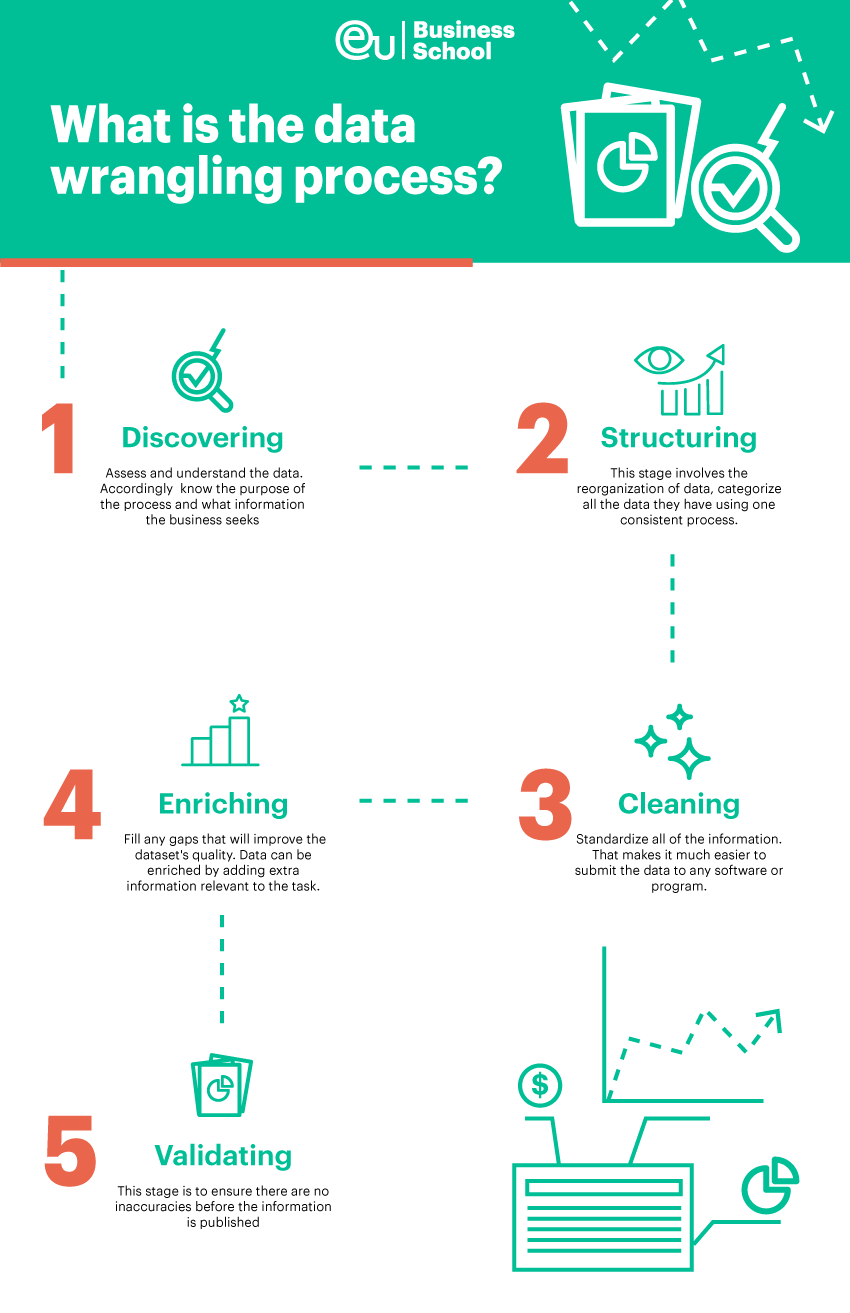Because it’s behind-the-scenes work, you may not realize just how crucial data is to business. As technology advances, it’s only becoming more important. In fact, a company’s success often depends on the skilled and knowledgeable professionals who wrangle data effectively on its behalf.
Read on to learn more about the importance of data wrangling and how these data wrangling techniques can be used to meet business objectives.
What is data wrangling?
The data wrangling process involves taking raw, unprocessed data and translating it into useful information that can drive decision-making. You may have heard data-wrangling referred to as data munging; these terms are used interchangeably to describe the same method.
For data to be useful, it must first be made understandable. Raw data can be very complex and detailed. Data wranglers clean, organize, analyze, and enrich data to draw meaningful conclusions from it. Part of the process might involve collating data from a range of different sources, allowing it to be combined or compared as needed.
Of course, not all data will be relevant at all times. Data scientists are responsible for sifting the data, finding missing elements or errors and accounting for those discrepancies in the final product. Data wrangling takes a lot of time, but it must be completed with accuracy and attention to detail.
Through data wrangling, raw data is transformed into a more accessible and comprehensible format. A data wrangler’s job is to refine this data into practical information that businesses can effectively use.
Why is data wrangling important?
During data wrangling, raw data is transformed into a state that is both reliable and relevant. In the world of business, data often comes from multiple sources and is stored on different systems. Data wranglers centralize the information so that it’s accessible and comprehensive, providing a complete picture.Ultimately, businesses make decisions based on data. That means any errors in the data could result in misguided decision-making and business failure. If the data that a business has collected remains impossible to understand, then it is useless. Data wrangling makes it a vital, valuable resource.
What is the data wrangling process?
Before data can be published and shared, data wranglers go through a five-step process:
1. Discovering
First, data wranglers assess and understand the data that they have. Then, to handle it appropriately, they need to know the purpose of the process and what information the business seeks. This helps them to determine what is relevant and what is not. At this stage, they work out the best approach for this specific dataset.
2. Structuring
The structuring stage involves the reorganization of data. Companies may have lots of information; however, it is often stored chaotically, across a range of mediums or on many systems. Data wranglers will categorize all the data they have using one consistent process.
3. Cleaning
It might sound strange, but yes, data can be dirty! If it has duplicates or errors, it’s low-quality data, and it’s not ready for processing. At this stage, data wranglers look to standardize all of the information they have. That makes it much easier to submit the data to any software or program.
4. Enriching
Sometimes the data you have doesn’t tell the whole story. At the enrichment stage, data wranglers look to fill any gaps that will improve the dataset’s quality. For example, data can be enriched by adding extra information relevant to the task.
5. Validating
The validating stage can be considered the final check. This is where data wranglers ensure there are no inaccuracies before the information is published. Without validation, there is a risk that invalid data will be used to inform decision-making. At this point, data is ready to be published and shared. Data wranglers often document each stage of their process alongside the data; this can be useful for future reference.

What skills and qualities are required to be a data wrangler?
Effective data wranglers possess the following skills and qualities:
Tech literacy – They will be expected to navigate a range of different systems and software so they can obtain and process information.
A meticulous mindset – Accuracy is critical in this line of work. Therefore, data wranglers must pay close attention to detail, always checking their work carefully.
Analytical skills – Data wranglers have to understand how the data relates to the purposes of the business. They provide the smallest details to build the bigger picture.
Patience – Data wrangling is a time-intensive process. No stage can be skipped or rushed through, so patience and dedication are required.
A methodical approach – To standardize the data, wranglers have to design and implement methods that may need to be repeated over and over again.
What’s the difference between data wrangling and data mining?
Don’t confuse data wrangling with data mining. This is something very different, although data wrangling can be considered part of the data mining process. However, both are important when gathering intelligence to inform business decisions.
When you mine data, you analyze it to find patterns. Data is much easier to mine for patterns once it has already been made understandable and standardized through data wrangling!
Once useless data is removed and all the data is properly formatted, data mining can be performed more easily. In this way, data wrangling can improve the efficiency of the data mining process.
What data wrangling tools are available?
Just some of the programs used by data wranglers in 2021 include Altair, Alteryx, Cambridge Semantics, Datameer, Infogix, Paxata, Trifacta, Talend, Tamr and TMMData.
New technology is being developed all the time to automate the data wrangling process as much as possible, saving businesses time and rigorous labor.
The future of data wrangling is worth paying attention to, as it will play an even more central role in an increasingly digitized future. However, automation is likely to advance and transform the process of data wrangling itself.










